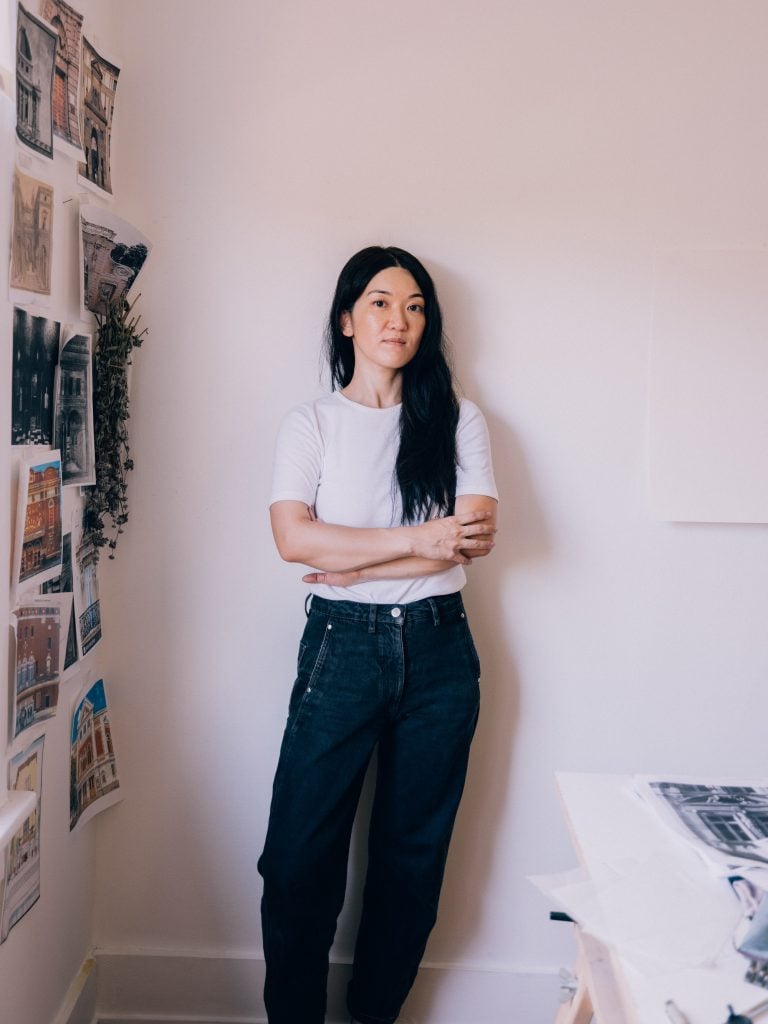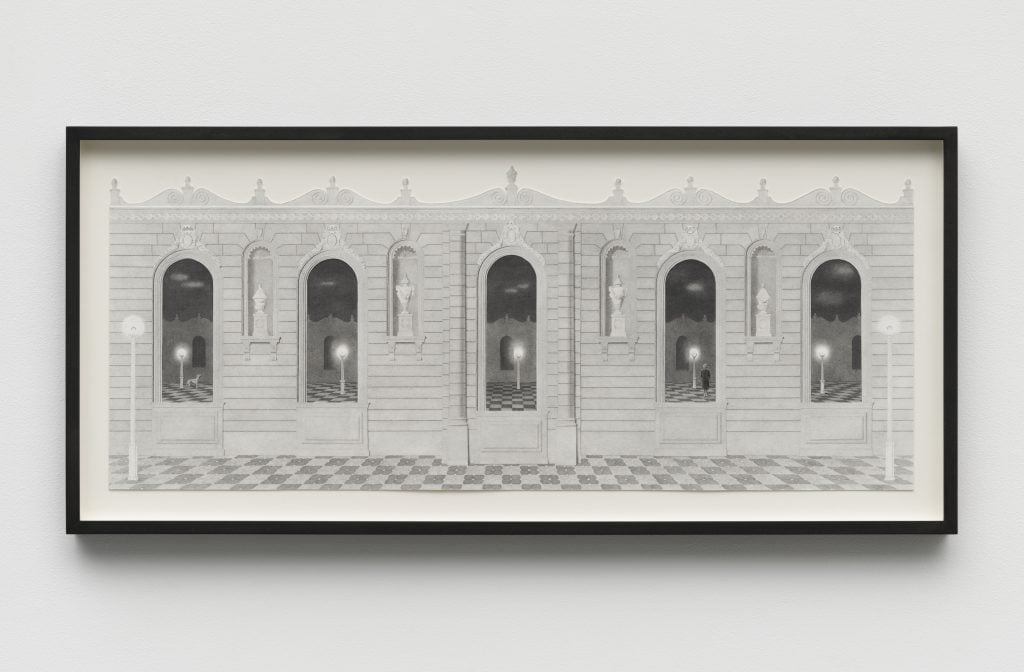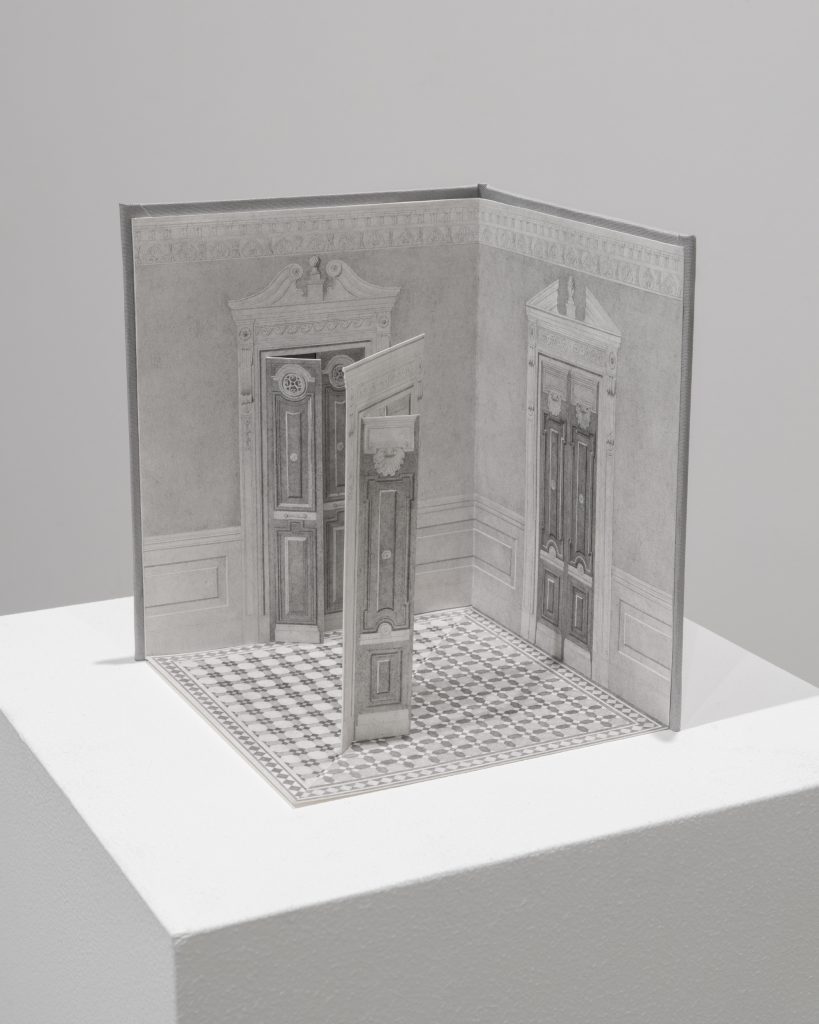Up Next
The ‘Illusion of Realism’ Haunts Milano Chow’s Intricate Drawings
The Los Angeles artist is capturing attention on both coasts with her grayscale architectural imaginings.

Los Angeles-based artist Milano Chow has an unlikely fascination with an obscure 18th-century artist named Jean-Jacques Lequeu. He was almost unknown in his lifetime and died, by all accounts, penniless.
Chow, who is known for her own ghostly, imaginative, and even fairytale-like drawings in two and three dimensions, discovered Lequeu’s work during the exhibition “Jean-Jacques Lequeu: Visionary Architect” which traveled to the Menil Collection in Houston in 2020. The mysterious French artist, who worked as a bureaucrat during the day, was an aspiring architect, and during his evenings, devoted himself to creating fantastical architectural visions set in otherworldly landscapes. These mind-bending worlds of impossibility rendered in pen and wash, are exquisitely detailed, a product of Lequeu’s solitary and obsessive imagination, and sometimes quite humorous.

Milano Chow, Colonnade Illuminated (2024). Courtesy of Chapter NY.
“There is this seriousness that he lends to his drawings, even if the image is so absurd,” said Chow, 37, on a phone call from her Los Angeles home. “With many of the artists who inspire me—they have that technique, but the work isn’t just relying on that technique. There’s something more there.”
Chow might as easily be describing her own works. The artist, who shows with Chapter NY in New York and Bel Ami in Los Angeles, mixes technical rigor with imaginative improvisation in her gray-scale mise-en-scènes. Taking inspiration from ornate architectural drawings, art history books, and magazines, Chow draws her intricate and imaginary architectural facades and interiors by hand. “These are not one-to-one translations of existing buildings, but a vague replica of the past,” she said, “These are not meant to be an authentic expression of real style.”
Starting with her hardest pencils, a 6H which leaves the faintest marks and is meant for technical drawing, Chow slowly builds up her scenes, gradually adding softer pencils and darker marks (she only ever works with the German brand of Staedtler pencils). From a distance, her drawings have a feel of airtight precision but are, with a second look, more playful and even impossible spaces. “Part of the process is this really slow buildup, that happens to be in black-and-white,” she added.
Women, chic and often solitary, sometimes appear in the windows and doorways of these ornate architectural tableaux, as though on stage sets or dollhouses. These figures are the only part of the composition she doesn’t draw herself. Instead, Chow lifts these women from fashion magazines, vintage ads, and internet searches using a toner transfer technique to create her very own “paper dolls.”

Milano Chow, Half Corner (2024). Courtesy of Chapter NY.
Oftentimes the artist cuts out the windows and doors of her drawings with a razor, then inserting these paper dolls into the space of the drawings themselves. This gesture creates a sculptural, shadowy effect that she enhances with additions of ink. When choosing which figures to add, Chow says she looks for something close to “timelessness”, eschewing figures wearing era-defining fashions, and at times altering the images to obscure the sources.
On some level, Chow’s works ask questions about the possibilities of photography today and have earned the artist a share of institutional support. In 2022, Chow opened “Prima Facie,” her first institutional solo show at the Aldrich Contemporary in Connecticut. The exhibition brought together a dozen recent works and underscored her unique engagement with Surrealism, film noir, and fashion magazines.
For Chow, who studied art history at Barnard College and taught herself to draw, there is a delight in reworking the past and the artistic trickery that is revealed through close looking. “At first glance, these might look like traditional architectural drawings, but the closer you look, the proportions are completely off or things become very nonsensical, the more you pay attention to them,” she said, “That’s the sensation I want. It gives the illusion of realism which is then completely thrown off.”

Milano Chow, Dual Facade with Tulip (2024). Courtesy of Chapter NY.
Windows, and a sense of watching, are ingrained in these works. Chow has been working in a monochromatic, architectural idiom for a decade at this point, but she continues to find fertile ground. In her 2015 solo exhibition The Painted Screen, at Chapter NY, the artist’s works were more closely cropped in on the portal-like spaces of doors, windows, fireplaces, and even mirrors. These spaces remain integral as her works have grown in scale, reaching toward world-building and at times stretching into three dimensions.
“Curtains, blinds, and windows appear in my work a lot,” she explained, “Of course, there is a question of voyeurism. Women appear in these works for the most part and there’s a long history of women being objectified, or being a muse. The reverse of that is a kind of exhibitionism. In these images, the women are aware of a camera and aware of being looked at.”
For Chow, who is preparing for a show at 1226 Gallery in Dallas in September with artists Will Rogan and Greg Carideo, as well as an exhibition at the Frank Lloyd Wright-designed Hollyhock House in Los Angeles in 2025, these women offer a place of orientation in a humorously disorienting world.
“We’re living in a very fragmented time when trends and styles feel very sped up. People don’t know how to position themselves. Everything’s up for grabs now, it feels like,” said Chow, “I hope people can take a little time to slow down, look closely at the works, and find the playfulness beneath the surface. Even if it’s just a tiny smidge.”





